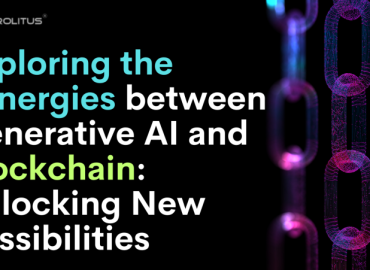Blockchain technology is revolutionizing the way we record, store, and transfer data. It is a decentralized, distributed public ledger that allows for secure transactions and data storage with enhanced privacy. Blockchain technology has been gaining traction in recent years due to its ability to provide more efficient, secure, and transparent methods of managing information. By permanently recording each transaction on a distributed ledger, blockchain eliminates the need for centralized third parties such as banks or governments to oversee transfers of money or other assets.
The use cases for blockchain technology are wide-ranging and span multiple industries including finance, healthcare, energy, and supply chain management. It offers an immutable way of tracking goods throughout their life cycle while also providing users with complete visibility into all transactions associated with an item or asset. Furthermore, it enables organizations to quickly verify customer identities while also protecting personal data from theft or misuse.
What are Blockchain Networks?
A blockchain network is a public ledger that records every transaction in chronological order. This ledger can be viewed by anyone who participates in the network, making it highly transparent and trustworthy. Every transaction is verified through complex cryptography to ensure its validity and authenticity before being added to the chain of blocks. All participants have access to this shared record of information which eliminates third parties from verifying each transaction individually, thus reducing costs and time spent on paperwork and manual processes.
Type of Blockchain Network
There are majorly 4 types of blockchains:
Public Blockchain Network
A public blockchain is the first variety of blockchain technology. This is where distributed ledger technology first appeared and where cryptocurrencies like Bitcoin helped to gain popularity (DLT). It eliminates the problems that arise due to centralization, such as a reduction in security and transparency. Instead of storing information in a single location, DLT disperses it across multiple peer-to-peer network nodes. Since it is decentralized, it is necessary to employ some data authentication methods. Blockchain members can reach a unanimous decision regarding the current ledger state by utilizing a consensus mechanism. With the use of consensus mechanisms, members in the blockchain can agree on the ledger’s present state. Two popular consensus techniques are proof of work (PoW) and proof of stake (PoS).
Anyone with internet access can go on to a blockchain platform to become a registered node because public blockchains are open and permissionless. This person has access to both new and old data and can do “mining operations,” which are complicated calculations needed to confirm transactions and add them to the ledger. On the network, no legitimate record or transaction can be altered, and because the source code is typically open source, anybody may check the transactions, look for errors, and suggest fixes.
Private Blockchain Network
A blockchain network that operates within a constrained environment, such as a closed network, or that is managed by a single entity is referred to as a “private blockchain.” Even though it works similarly to public blockchain networks in that it uses peer-to-peer connections and decentralization, this type of blockchain is much smaller. Private blockchains are typically run on a small network within a company or other organization, as opposed to public blockchains, which allow anybody to join and contribute computing power. In some circles, they are also referred to as “enterprise blockchains” or “permissioned blockchains.”
Hybrid Blockchain Network
Hybrid blockchain is a type of blockchain technology that includes both private and public blockchain components. Organizations use it occasionally to obtain the benefits of both types of blockchain. It gives businesses the ability to set up both a private permission-based system and a public permissionless system, giving them control over which data is made available to the public and who has access to it. It also allows companies to create private, permission-based, and public permissionless systems.
When a hybrid blockchain is used, transactions and records are usually kept private, but they can still be checked when necessary. For instance, access can be granted using a smart contract. Even though it is protected within the network, confidential information can still be checked. Even if a private company owns the hybrid blockchain, that company will not be able to make any changes to the transactions.
When a person joins a hybrid blockchain, that person is granted unrestricted access to the network. However, other users can’t find another user’s identity unless they do business with that person. After that, the opposite person is made aware of the other person’s identity.
Consortium Blockchain Network
Consisting of both private and public blockchain elements, consortium blockchain, sometimes referred to as a federated blockchain, is the fourth form of blockchain. However, it differs in that a decentralized network is used in collaboration by numerous organizational members. A consortium blockchain essentially functions as a private blockchain with restricted access to a certain group, removing the hazards associated with having just one entity control the network on a private blockchain.
The consensus processes in a consortium blockchain are managed by predetermined nodes. It has a validator node that performs transaction initiation, receipt, and validation. Member nodes have the ability to send or receive transactions.
Developing a Blockchain Network: Steps to take
Step 1: Identify a Suitable Use-case
The blockchain has generated a lot of interest, and we know that blockchain technology can end poverty, end world hunger, and clean up corruption without anyone having to do anything. But, unfortunately, that is not the case. So the first step is to identify a use case that makes business sense.
These are the three things that blockchains excel at:
Data authentication and verification: To authenticate and verify data, you can use encryption, digital signatures, and immutable storage. Data can be stored on the blockchain in almost any format. Blockchains can also be used to make and verify public-private key pairs and digital signatures.
Smart asset management: Escrow, retirement, exchange, payment, and exchange are all included in smart asset management. A smart or crypto asset is a tokenized version of a physical asset, such as gold, silver, oil, or real estate.
The term “smart contracts” is frequently misunderstood, but that’s a topic for another day.
Step 2 Finding the Best Consensus Mechanism
Proof of work served as the consensus mechanism for the original blockchain, which runs the bitcoin cryptocurrency. However, today’s distributed ledger technologies offer a variety of consensus mechanisms, including Proof of Stake, Byzantine Fault Tolerance, Deposit-Based Consensus, Federated Byzantine Agreement, Proof of Elapsed Time, Derived PBFT, Redundant Byzantine Fault Tolerance, Simplified Byzantine Fault Tolerance, Round Robin, and Delegated Proof of Stake.
You must select the consensus mechanism that makes the most sense for your use-case.
Step 3 Finding the Best Platform
Several blockchain platforms are currently accessible, most of which are open source and cost nothing. Taking into account the consensus method you selected in step 2, you must choose the ideal blockchain platform.
A few of the more well-known platforms are:
- Corda
- Blockchain Domus Tower
- Eris
- Ethereum
- Hyperledger Fabric
- HydraChain
- Sawtooth Lake
- OpenChain
- Quorum
Step 4 Designing the Nodes
There are permissioned blockchain systems and permission-less blockchain systems (such as a government-run land registry) (e.g., Bitcoin, where anyone can become a miner). A contract management system implemented in a pharmaceutical company is an example of a private blockchain solution. Another illustration of a public blockchain solution is cryptocurrencies backed by assets (e.g., a group of banks running a shared KYC platform).
Another issue to consider now is whether the nodes will run on-premises, in the cloud, or both. Then, problems with the hardware setup, such as processors, memory, and disc space, appeared. Finally, you must also decide on the central operating system (usually Ubuntu, CentOS, Debian, Fedora, Red Hat, or Windows).
Step 5: Design the Blockchain Instance
Most blockchain platforms need very carefully planned configuration for the following elements:
- Permissions
- Asset issuance
- Asset re-issuance
- Atomic exchanges
- Key management
- Multi signatures
- Parameters
- Native assets
- Address formats
- Key formats
- Block signatures
- Hand-shaking
Some parameters can be changed at run-time but some cannot, so this is a very crucial step.
Step 6: Building the APIs
While some blockchain platforms come with pre-made application programming interfaces (APIs), others do not. The most important application programming interfaces (APIs) that you will need are:
- Generating key pairs and addresses
- Performing audit-related functions
- Data authentication through digital signatures and hashes
- Data storage and retrieval
- Smart-asset lifecycle management –issuance, payment, exchange, escrow and retirement
- Smart contracts
Step 7: Design the Admin and User Interface
At this point in the process, you will have to choose the front-end and programming languages, such as HTML5, CSS, PHP, C#, Java, Javascript, Python, Ruby, Golang, Solidity, Angular JS, and Node.js. You would also have to decide on servers and external databases, such as MySQL or MongoDB, among other options, including web servers, FTP servers, and mail servers.
Step 8: Adding Future Tech
Integrating Artificial Intelligence, Biometrics, Bots, Cloud, Cognitive Services, Containers, Data Analytics, the Internet of Things, and Machine Learning into your Blockchain system is a terrific way to boost its capabilities significantly.
Setting Up Nodes: Requirements for nodes
Blockchain nodes allow users to access and store data on the blockchain securely. Setting up a blockchain node requires careful consideration of the environment needed for operation as well as technical requirements such as hosting, maintenance, and security protocols.
But because setting up and configuring nodes takes a lot of work and time, “node providers” now offer their services to other startups or companies that want to use the blockchain.
At Prolitus, we have seen several businesses that have decided to build their project on blockchain and turn to specialized blockchain service providers to set up nodes.
Blockchain service providers make nodes available to businesses and individual developers as a tool that lets them make decentralized apps faster without spending their engineering time maintaining and managing nodes.
When setting up a blockchain node, it is essential to consider the environment necessary for its operation. In most cases, this includes dedicated resources such as CPU/memory capacity, disk storage space, network bandwidth, and adequate cooling systems. Also, it’s essential to plan for hosting solutions that offer reliable uptime and options for scaling when more resources are needed in the future.
Blockchain Security and Scalability: Ensuring safety & performance
When deciding if an implementation project is ready for production, the two most critical non-functional requirements for IT systems are how well they work and how well they can be expanded. This is especially true in a blockchain network because of its distributed and decentralized design, which enables peers to interact with one another and develop confidence throughout a business network. Each peer node needs to do calculations and talk to the other peers to validate transactions, come to a consensus, and update the shared ledger. Therefore, to make informed judgments regarding the architecture of a blockchain-based system, one must know the factors that influence the blockchain’s performance and the prospects for improvement.
People often measure the performance of blockchain networks by figuring out how long it takes for a transaction to be validated and stored in each peer node in a way that makes it impossible to undo or cancel. It is essential to keep in mind that the number of concurrent transactions that can be processed in a given length of time is not the same thing as throughput, even though this is commonly referred to as throughput. Scalability is the ability of a blockchain network to handle both a rise in the number of network nodes and an increase in the number of transactions. Scalability can only be achieved when both of these factors are present.
Factors affecting how well blockchain performance
A consensus protocol or algorithm is the technique by which a transaction is distributed, confirmed, and accepted in a blockchain network. Therefore, this approach may also be called the “consensus method.” Consensus process: This consensus mechanism strikes a careful balance between how decentralized, scalable, and secure a blockchain network is. Moreover, it is responsible for maintaining the integrity of the blockchain. Because of this, the chosen consensus method has a lot to do with how well the blockchain network works.
Network latency is the most significant problem affecting the network’s overall performance when organized in a distributed design. For example, a transaction needs to be sent out to every node before it can be validated, and the responses from those nodes need to be collated before a majority-based consensus can be reached. As a result, dedicated network bandwidth helps reduce the time between network operations and increases the overall throughput.
Infrastructure for nodes Each node in a blockchain is composed of a runtime engine and a database that can be hosted in the cloud or locally. In the lack of specialized infrastructure resources, the node’s performance will likely be negatively impacted (such as CPU, RAM, and hard drive). Consequently, it is of the utmost importance to prepare for the appropriate allocation of IOPS (Input Output Operations Per Second) and the size of the infrastructure.
The total number of nodes When there are more nodes in a network, reaching consensus and propagating transactions take longer, which in turn causes the system’s performance to degrade more severely. Methods that reduce transmission costs and make it possible for nodes to rely on the validation history of a leader node and other peer nodes are being developed to solve this problem.
The Complicated Nature of Smart Contracts The vast majority of benchmarking studies and assertions are founded on trials carried out in a laboratory under strictly controlled conditions for the simplest types of transactions. However, the total number of reads and writes to and from the ledger and the level of sophistication of the validation logic in smart contracts are all factors that can affect the system’s overall performance.
Size of the Payload Contained in a Transaction Because each node in the network must receive both the transaction and its payload, replicating larger payloads takes significantly more time. As a result, one of the best practices is storing enormous payloads and documents in an off-chain storage location while maintaining a blockchain reference.
Keeping track of transactions and the ledger’s current state is typically made possible by key-value pair data stores supported by blockchain networks. Since there is a significant amount of read-write activity across the web, the efficiency of the network’s database is essential in deciding how well the network will function.
Even though a blockchain network is composed of several nodes and offers high availability as a whole, the number of transactions that will be accepted for further processing is determined by the transaction handling capacity of each node. This is true even if the network consists of several nodes. And this has an immediate impact on the overall throughput of the network.
Millions of nodes make up public blockchain networks like Bitcoin and Ethereum, which make cryptocurrency transactions possible. However, since trust has to be built between people who don’t know each other, a mining-based consensus method takes a long time and requires a lot of computing power. Consequently, the transaction’s completion needs to be accomplished promptly, resulting in low transaction throughput. Because of this, public blockchains are known for being slow and not being able to grow. So, software developers must come up with workarounds like side chains instead of using the main chain to process transactions.
Private permissioned blockchain platforms are used to build a consortium with a limited number of nodes for business use cases like B2B and B2C transactions between known parties. In addition, the throughput is significantly increased due to implementing a more efficient consensus method, which does not call for proof of work before committing transactions to the distributed ledger.
A new generation of DLT-based blockchain platforms has emerged, sometimes called blockchain 3.0. (distributed ledger technology). These platforms help solve performance and scalability problems by utilizing data structures such as the directed acyclic graph and reducing the processing latency of transactions by using cutting-edge validation and voting processes.
Final Thoughts: Benefits of creating a blockchain network
Blockchain technology is nothing short of revolutionary for anybody and everyone who desires to use it and become proficient with it. Let’s discuss some of the benefits of blockchain technology:
Blockchain technology has made it possible to view transaction history in a manner that is more open and accessible than ever before. Because it is a certain kind of distributed ledger, each node in the network has its own copy of the documentation. A blockchain ledger makes it easy for anyone to access its data. If a change is made to a transaction’s history, all users in the network will be able to see both the difference and the updated record. Because of this, no one is kept from getting any information about currency exchange.
Regarding security, the blockchain is head and shoulders above all other record-keeping systems. This is true regardless of the metric you use. The transaction records shared among blockchain users can only be updated and/or modified by the network’s consensus. A change is made to a record only if the vast majority of nodes or all of them agree. When a transaction is accepted, it is encrypted and linked to the one that came before it. Because of this, one person or entity can’t change the information in a record. Because blockchain is decentralized, no single entity possesses the autonomous authority to change the documents it stores. Any industry that has an absolute requirement to keep sensitive data safe, such as governments, healthcare, financial services, and so on, can utilize blockchain technology to implement stringent security measures in their operations.
Traditional paper-based processes make it hard to complete a transaction quickly because they require the involvement of many people, leave room for mistakes, and depend on physical documents. Blockchain technology could streamline and standardize these old ways of doing things, making trades less likely to go wrong and making them work better. Furthermore, because there is just one ledger to keep track of everything, the parties don’t have to worry about keeping separate records, so the space is substantially less cluttered. In addition, when everyone has access to the same information, it is much easier to develop trust among individuals. Lastly, settling disagreements doesn’t have to be hard or take a long time if no middlemen are involved.
Traceability is a difficult task in sophisticated supply chains because it is difficult to track goods back to their sources. However, with blockchain, the transactions of objects are documented, providing an audit trail that enables you to discover the source from which a certain item was obtained. In addition, you are given information regarding every stop the goods made along the journey. With this level of tracking, customers can be sure that the product is real and fraud can’t happen.
The ability to conduct audits is another aspect of the presented argument. Since every transaction with an asset is recorded on the blockchain, you can already check the authenticity of your asset and make sure it is real.
Because blockchain technology eliminates the need for middlemen and other third parties, businesses and other organizations have the potential to realize significant cost savings. Because you can place your trust in the other party involved in the transaction, you do not need anybody else to draft the terms and circumstances of the trade for you. Making the ledger available to all parties in a single, unchangeable version can also reduce the time and money spent on documentation and the changes it needs.





